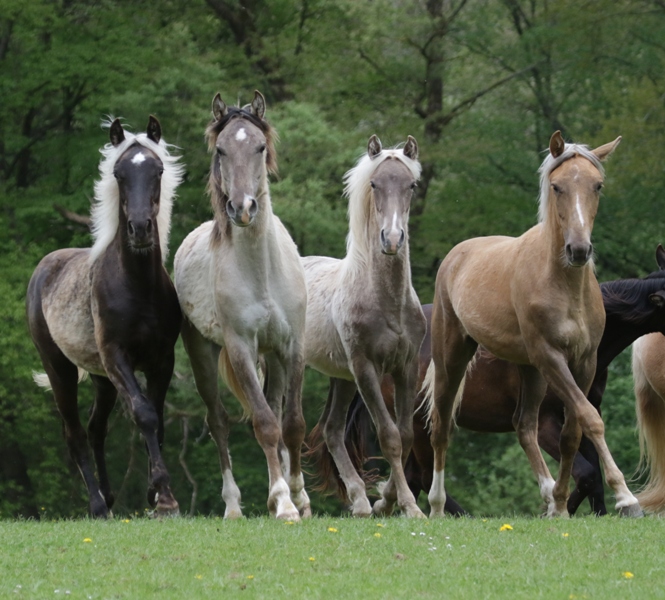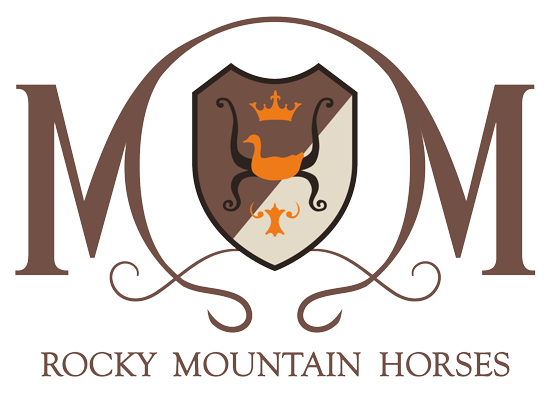Frequently Asked Questions
Price Categories:
Cat A 4.500 - 7.500 EUR
Cat B 7.500 - 10.000 EUR
Cat C 10.000 - 12.500 EUR
Cat D 12.500 - 15.000 EUR
Cat E 15.000 - 17.500 EUR
Cat F 17.5oo EUR and more
These prices include German VAT, which is 19% currently. Please realize that if you are a professional you can buy horses tax-free! Members of non-EU countries can also buy tax-free!

I am often asked when I wean the babies … and people seem disappointed when I say they are weaned at 6-7 months. There is a misconception that it is particularly humane to keep foals with their mothers for a longer time.
Have you realized what effect it has on the mother? They lose weight and back muscles as milk production costs a lot of energy, and are bitten and their udders been treated very roughly. I am a firm believer of keeping horses in herds, preferably with their fathers, aunts and many other foals. The herd structure and family bonds give the foals a lot of security and stability. Taking the mother away who is often only seen as a milk bar at their convenience, has far smaller effect on the foals than taking away their friends.
I keep the weanlings at home in a large walk-in shed with a paddock with hay 24/7 and extra oats as they undergo their biggest growth spurt in their first year.
By watching moms condition, she can have a new foal in spring and give the surplus energy to her fetus. This means that she can live a best possible life in a herd with no grass restriction and in complete freedom in large pastures. If mom is not pregnant, she will need to be kept on a tighter diet and can‘t enjoy pasture 24/7, as Rockies tend to get fat when not ridden intensively and are laminitis-prone.
If ever you hear a breeder tell you that Rockies always gait right from the beginning of training, no matter what, because they are naturally gaited and „it’s in their genes“ … buyer beware!!!!
Yes … it is true that they are naturally gaited. All our foals show gait in the pasture and the recent studies of Uppsala University show that there is a gait gene (DMRT 3 gene) and that 99,9% oft he RMH carry it. BUT … four beat gait or tölt/ single foot is very prone to rhythm problems as it requires a good balance of the rider and the horse. There is no moment of suspension, so there is always one hoof on the ground and therefore easy to be disrupted. So imagine a young horse, struggling with balance already with a rider on ist back … It is very helpful for the horse if the rider is experienced with the gait to give the horse the support it needs. Finding balance with a rider on its back is a big issue for a green horse.. so it is only natural for a horse to maybe sway from diagonal emphasis to lateral (pace) disbalance.
If you are not experienced with the four beat gait, invest the time and money to have your horse get a basic training from a professional.. and don’t forget about training yourself as well.. it will save you a lot of frustration along the way. Because keep in mind: no gait is as difficult and tricky to perform as a four-beat gait! But then it’s the best ride and gaiting is addictive!
Some excellent footage of the Rocky Mountain and ist different gait styles was made by the US Trainer Travis Robinson … here you can clearly see the differences, all horses being registered RMH and within the breed Standard.
Everybody can remember the first Rocky they saw in a magazine or book, and they were all the signature color of the RMH: CHOCOLATE! There is something about that rich dark brown color in contrast with a cotton white mane and tail, right? Or some have beautiful dapples to boost.
BUT … I often hear people say: “Rockies are gorgeous but don‘t they have an eye problem (ASD/ MCOA)?” No! Not rockies but chocolate colored horses in general that are homozygous for the chocolate gene are. It is seen in Icelandics, Classic ponies, Comtois, etc too.
So whats the deal? Keep away from the homozygous ones and you should be fine. The single gene horses are not more prone to eye problems than any other horse. (Unfortunately enough there is a rising incidence of uveitis problems related to leptospirosis.)
Why do people (mostly breeders) still buy homozygous horses? Because they will always produce a chocolate offspring (except in chestnuts it isn’t visible). And as the market shouts for chocolates, it is desirable to produce many. Then again it is not the color that defines a good breeding horse!
Another topic that I am often asked about is why rockies are so expensive?! Okay … let me begin by saying that most other breeds are far too cheap, allowing no profit and causing losses for those who are tempted to breed. I remember a saying: I made a small fortune breeding horses, having started with a big fortune!!!
Now with the rocky we have found a breed that is very popular and the demand exceeds the supply. So there are not many horses for sale in Europe. The other difficulty is that the large breeders in the USA have stopped breeding after the bank crisis and recession of 2008/2009. There used to be large scale breeders in Kentucky who produced 30+ foals every year. This means that if you are looking for good breeding stock in the USA now, they are rare and expensive. Then if you are lucky to find a high quality horse … you might have bought it, but it still needs to embark on a long and costly journey: shipping over land from Kentucky to Texas to start a 30 day quarantine with many blood tests and lab work. Then the horse is shipped to the animal lounge of the Houston airport to be prepared for a flight with a cargo plane in crates of three horses. Then they are flown to Frankfurt airport and again state vets check them and they are assesed by customs: many fees need to be paid.
So you must easily add another € 7.000 – 8.000 on top of the purchase price you already paid! If you are a serious breeder with a business plan, you will need to calculate your sales prices based on the investments made. This will result in a higher price than a European based breed.
Another issue I would like to clarify here about quality and pricing is about clients searching for „just a simple recreational horse … nothing fancy or showy … just a sweet laid-back horse with an easy clear gait for trail riding“. That describes exactly the perfect RMH! And they don’t come cheap just because they aren’t showy. Of course there exists showy, flashy Rockies but that isn’t what most people are looking for and what the breed is about!
Mission Statement
It has always been my goal to produce the best possible RMH with the typical traits as described by the association. I was never in the breeding business for the money. I hoped to breed the ultimate recreational horse making its owner happy with a long life of health, good genes and a friendly disposition. I often bought the horse that was NOT for sale, just because I figured it must be the one I should use in a breeding program.
Practically ALL my horses were imported from the USA, because the horses I wanted to have for my program were not for sale in Europe! Choosing horses that were successful in the Kentucky show scene was costly but worth it. They proved themselves with great competition in the show ring in the area they originally came from. Many National Champions were imported and passed on their genes to European offspring. It can be argued that I might have paid too much myself but it was the quality that counted and not a bargain deal. I believe that in the long run it is worthwhile to invest in the best of quality. And never forget: it costs the same amount of money to raise a lousy horse than to raise a good one!
A Few Numbers
We started breeding Rockies in 2011. A decade later, approximately 130 RMH foals will have been born with the MVM name.
In this past decade, 76 Rockies and 3 KMSH were imported from the US! Among them many National Champions I’d like to list here:
MX Wrangler, VBFs Heart Of Motion, Blue Mountain Spirit, For A Few Dollars More, HCRs Split Second, Classics Cha Cha Cha, Purdue’s Not So Innocent, Stardusts Midnight Matinee, Nicks Nicole, Sheez Fit To Be Tied, Miss Indiana, CA Toco Dawn, Banjos JoAnna, South Forty Sweet Sienna, Dreamcatchers Best Kept Secret and last but not least the winner of the very prestigious Rea Swan Versatility Award, Hersheys Bit-o-Honey!
Other stallions imported that made their mark in Europe were MX Gabriel, GHS Held For Ransom, Rocky Vs Reb!
